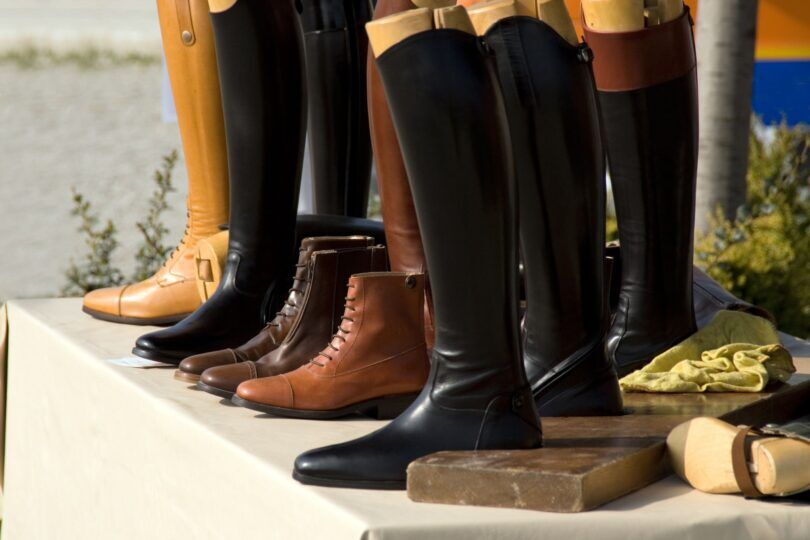The Great Boot Height Dilemma
If you’re anything like me, you’re always checking out other riders’ footwear in the barn aisle. After all, boots are a key component of a good ride, which means it’s important to choose the best pair. But how do you choose between a short boot and a tall boot?
Riding boots come in a range of heights, from short boots to tall boots. Short boots are generally ankle height and tall boots usually go to the knee. For Western riders, there’s a convenient mid-boot option that comes to about mid-calf. Many riders will wear different boots for practice than for show.
While both short and tall boots are appropriate for riding, many riders prefer the stability and protection of a tall boot.
Boot height definitions vary somewhat between English and Western riding disciplines. In general, a short boot is no taller than mid-calf, more commonly ankle height. Tall boots are mid-calf and taller (though they often hit just below the knee).
When to Wear What
English riding boots are most broadly separated into short boots (paddock and some muck boots) and tall boots (show boots).
Practice
When schooling, many riders may opt for a paddock boot and a pair of half chaps. More advanced riders may school in a leisure pair of tall boots. And some riders will hop on in a pair of muck boots (make sure they have a one-inch heel!).
Source: Canva
Show
Shows almost always require a tall boot. At some of the lower levels, paddock boots with half chaps are acceptable.
Source: Canva
Various Styles of English Boots
- Paddock boots (short)
- Tall boots (show)
- Tall boots (leisure)
- Muck boots (short or tall depending on type and season)
Tall & Short Western Riding Boots
Western boots have a wider range of heights, so it can be more challenging to find the right height. A pair that works great for chores may not be the right height for riding.
There are three main western boot heights.
Short (6” – 9” uppers)
Pros
Short boots, like Ropers, are a more recent design that also tends to have a lower heel. They are very comfortable for doing barn chores and the designs tend to feature flexible soles for improved fit.
Cons
The tops have a habit of getting stuck on the saddle’s fender, which can be annoying.
Mid (9” – 11” uppers)
Pros
Mid-height boots offer the best of both worlds, being equally suited for working and riding. The heels tend to be a bit lower than other styles, which makes being on your feet all day a breeze. Plus, the soles usually have treads and cushioning (anti-slip + comfort for the win).
Cons
These boots tend to be more affordable than other options, which means they can have a cheaper look. They’re also not as intricate in their designs as other boots.
Tall (12”+ uppers)
Pros
These boots are similar in many ways to mid-height boots. The heels tend to be higher, and riders often love the ankle and calf support & protection of these boots. Plus, at a higher price range, the designs tend to be stunning and the leather of great quality.
Cons
Depending on the exact height, tall boots may be too tall for showing (the taller the boot, the bulkier they tend to look under pants). Many of the taller boots (13”+) may be better suited as fashion boots than functional riding boots.
Frequently Asked Questions
Q: Are tall boots better for riding?
If you’re an active competitor in eventing,
Q: How tall should riding boots be?
This really comes down to personal preference. For English riders, some love them tall and others prefer a shorter boot. For Western riders, you’ll want a slightly taller boot (10+ inches) to avoid stirrup and saddle issues.
Q: What are the benefits of tall boots?
Tall boots can prevent pinching or chaffing from the stirrup leathers, while providing extra protection (and extra warmth in the winter). Some riders feel tall boots keep their legs more stable.
Q: When should I get tall boots for riding?
Tall boots are expensive, so wait to invest in a pair until you’re moving up the levels or in a consistent show program.
Parting Thoughts
This age-old debate will likely never be settled, so don’t be afraid to experiment with boot height to figure out what works best for you.
P.S. Enjoy this article? Trot on over to:
- 6 Short Horse Riding Boots with Full Size Fashion
- 6 Best Shipping Boots for Horses on the Move
- 16 Best Women’s Riding Boots for Everyday Equestrians
- 12 Best Cowboy Boot Brands You Won’t Regret
- Best Boots for Western Horseback Riding



